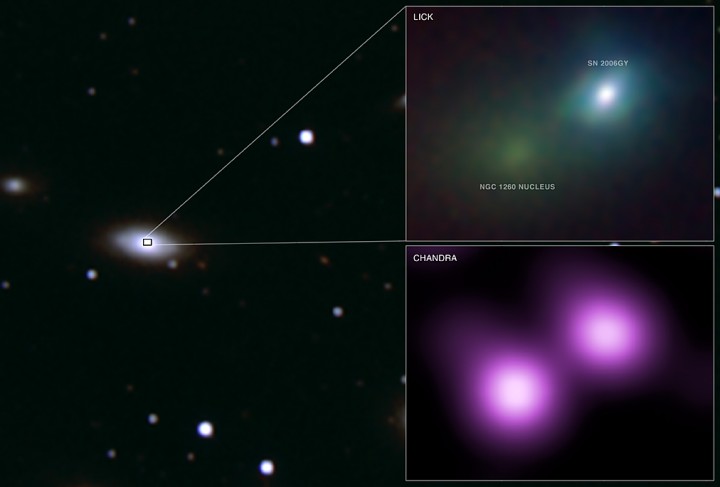Credit & Copyright: X-ray:
NASA /
CXC,
Nathan Smith, Weidong Li (UC Berkeley)
et al.;
IR: Lick/UC Berkeley/J.Bloom, C.Hansen
Explanation:
The stellar explosion cataloged as
supernova
SN 2006gy shines
in this
wide-field image (left) of its
host galaxy, NGC 1260,
and expanded view (upper right panel) of the region surrounding
the galaxy's core.
In fact, given its estimated distance of 240 million light-years,
SN 2006gy was brighter than, and has stayed brighter
longer than,
any previously seen supernova.
The Chandra observations in the lower right panel establish
the supernova's x-ray brightness and lend strong
evidence to the theory that
SN
2006gy was the death explosion of
a star well over 100 times as massive as the Sun.
In such an exceptionally massive star,
astronomers
suspect an instability producing matter-antimatter
pairs
led to the cosmic blast and obliterated the stellar core.
Thus, unlike in other massive star supernovae, neither
neutron star,
or even
black hole,
would
remain.
Intriguingly, analogs in our own galaxy
for SN 2006gy's progenitor may include the
well-known,
extremely massive star Eta Carinae.
IR: Lick/UC Berkeley/J.Bloom, C.Hansen
1999 2000 2001 2002 2003 2004 2005 2006 2007 2008 2009 2010 2011 2012 2013 2014 2015 2016 2017 2018 2019 2020 2021 2022 2023 2024 2025 |
Yanvar' Fevral' Mart Aprel' Mai Iyun' Iyul' Avgust Sentyabr' Oktyabr' Noyabr' Dekabr' |
NASA Web Site Statements, Warnings, and Disclaimers
NASA Official: Jay Norris. Specific rights apply.
A service of: LHEA at NASA / GSFC
& Michigan Tech. U.
|
Publikacii s klyuchevymi slovami:
supernova - Sverhnovye
Publikacii so slovami: supernova - Sverhnovye | |
Sm. takzhe:
Vse publikacii na tu zhe temu >> | |
